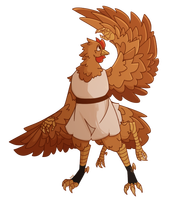- Created
- 1 year, 10 months ago
- Creator
- YeeshaStone
- Favorites
- 0
Profile
Physical Defects and Abnormalities
Polymelia
A very rare birth defect, Polymelia is the name of the condition where an Aves is born with an extra set of limbs. It is extremely rare for this to happen, but when it does it almost always is an extra set of back legs. These legs grow at the same rate as the main pair but do not have muscles or tendons making it impossible for them to move on their own or really have any functional use. They also are frequently a bit shorter then the Aves main legs causing them to hang limply behind their real legs as some sort of strange accessory. Most Aves will have these extra limbs removed soon after birth so as to not cause them trouble throughout life, but there are a few who choose to hold onto them because they don’t want to risk becoming infected from the surgery or feel a strange connection with them. If they are not removed then the Aves must be vigilant in making sure they stay clean and free of any cuts or bruises as their extra limbs can become infected just as easily as any other part of their body but are harder to keep track of then their normal limbs. They can not feel any pain in these faux limbs making it hard to tell if they have been hurt or damaged.
To date, there have only been one or two cases where an Aves has gained an extra set of arms due to Polymelia, but they did not live for very long. In general an Aves with Polymelia does not have a long life span. This isn't’ because of the extra limbs though, but rather Polymelia often accompanies other birth defects that are much more life threatening. Although not common, a number of Aves have lived a long and healthy life with their extra set of of legs.
Scissor Beak
A somewhat common deformity among Aves is called Scissor beak, although it is occasionally called Cross beak. Like the names imply a Aves has Scissor beak when their top beak and bottom beak divert from their regular patterns and cross. The top beak will often veer off to one side of their mouth and the bottom beak the other. This defect can make it extremely hard for an Aves to eat or even speak depending on how severe the affliction is. To help combat this many Aves who have Scissor beak will clip or file off the part of the section of beak that is crossed to help them be able to function properly again. When clipping they have to be careful as partway up a Aves beak blood and nerves can be found, however the tip of the beaks have no sensation in them whatsoever. Eventually the beak will grow back skewed and they will have to trim it again, but it works as a temporary fix. There are a few Aves that get fed up with having to continually do this. All will have their top beak amputated off so they don’t have to deal with a scissor beak, replacing the missing part of their face with a metal or wood attachment. To most this seems like a drastic measure, but for them it's worth it.
An Aves can get Scissor beak one of two ways. The least common way is having it from a birth defect. Those that are born with it often have the most drastic form of it with both halves of their beaks being wildly off center making functioning very hard often leading to the Aves eventually refusing to eat due to how painful it can be and passing away. The less extreme, and much more common version of Scissor beak happens when an Aves has part of its beak chopped off for the first time. Whether it is clipped, bent or chopped, if the beak is majorly damaged on an Aves it will grow back, but will do so in a strange manner often resulting in scissor beak stemming from the location that the deformation was first made. Because most accidental beak clippings happen near the end of the beak, this means that the Aves issues with eating or talking will be limited and easy to remedy with a simple filing.

